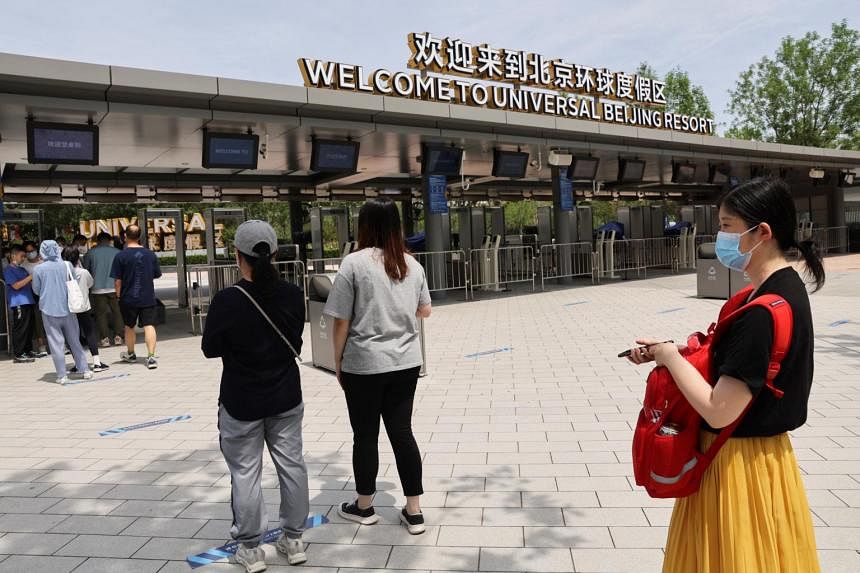BEIJING (BLOOMBERG) - China’s revised Covid-19 guidelines that cut quarantine in half for inbound travellers also created a standardised policy for mass testing and lockdowns when cases flare, showing the country still has a zero tolerance approach to the virus.
President Xi Jinping solidified the position during a trip to Wuhan, where the pathogen was first reported in 2019, saying China is capable of achieving a “final victory” over the coronavirus.
The Covid Zero policy is the most effective and economic approach for the country, Mr Xi said on Tuesday (June 28) during the visit, the official Xinhua News Agency reported.
The first update of the National Health Commission’s protocol since May 2021 sparked enthusiasm in financial markets and increased demand for travel by cutting quarantine time in half, with some analysts projecting it may signal the start of China’s withdrawal from the Covid Zero approach that largely cut it off from the rest of the world since 2020.
A closer reading of the document shows it is codifying critical Covid-19 policies that have widely varied until now and lays the groundwork for faster and more extensive deployment of testing and lockdowns.
Even with reducing quarantine times to 10 days from as long as three weeks, China remains one of the most difficult countries to enter.
“They are modest steps that do not materially change China’s overall Covid stance,” said Mr Louis Kuijs, Asia Pacific chief economist at S&P Global Ratings. “Indeed, as long as ‘dynamic zero’ remains the overall guiding principle, new outbreaks pose serious risks to the economy.”
The move further consolidates and adjusts China’s Covid Zero strategy given the more infectious nature of the omicron variant, and explains how local officials are expected to deal with the virus in the future.
“The protocol comprehensively follows the dynamic zero policy,” said Mr Mi Feng, a spokesperson for the National Health Commission, during a briefing on Tuesday. “It’s not loosening control. The goal is to be more scientific and accurate.”
The guidelines detail testing and control measures for different levels of risks that can be implemented across China.
In areas classified as “high risk,” where Covid-19 has been detected in neighborhoods or workplaces, people are strictly banned from leaving their homes.
The level will be downgraded to “middle risk” after the area has been deemed virus-free for a week and everyone tests negative on the seventh day.
Another three days of zero infections will put the area in the “low risk” category.
For large cities, including provincial capitals and places with more than 10 million residents, mass testing should be conducted every day in virus-hit areas, stopping only when no community cases are found for three days in a row.
Residents should undergo another round of tests three days later, ending only if there are still no new infections.
If the virus has spread across districts, provincial level health authorities will make the call on whether citywide testing is needed.
The Ministry of Industry and Information Technology scrapped a measure that flagged local travellers who had been in a medium- or high-risk city within the past two weeks.
The programme, which put an asterisk on their digital travel history cards, led some locations to impose curbs or quarantine stays on those visitors.
Its removal was greeted with enthusiasm, with news about it trending on the social media site Weibo.
Searches for train travel within China also surged, as residents took the change to mean that it would be easier for people from cities with recent outbreaks – like Beijing and Shanghai – to travel and avoid lengthy quarantine stays.
The standardised rules are also aimed at preventing local authorities from intensifying curbs on their own, a common phenomenon as municipal Communist Party officials fear angering Beijing by failing to execute Covid Zero policies.
The rules were almost immediately put to the test, as the detection of 15 infections in central Anhui province, due west of Shanghai, led to the lockdown of one county with 760,000 people on Wednesday.
Shanghai and Beijing, which battled outbreaks throughout the spring, both reported no new local infections for Monday, a milestone that was seized upon as showing the Covid Zero strategy can be successful.
On Tuesday, the financial hub again reported zero cases, while the capital saw one new infection.
Nationwide, there were 39 Covid cases reported for Tuesday, maintaining low levels not seen since February.
The National Health Commission also created an open message board on its website for the public to report issues directly.
Earlier, the top health regulator detailed nine things it said were being done improperly, mainly containment measures that were going too far and triggered criticism on social media.
The health regulator, along with other government ministries, has established a team to supervise and regulate ongoing virus prevention measures.











